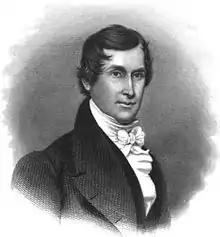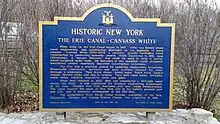Canvass White
Canvass White (September 8, 1790 – December 18, 1834) was an American engineer and inventor. He was chief engineer at the Delaware and Raritan Canal and he patented Rosendale cement, which became the dominant cement in the United States until 1900.
Canvass White | |
|---|---|
 White depicted in an 1871 illustration | |
| Born | September 8, 1790 Whitestown, New York, U.S. |
| Died | December 18, 1834 (aged 44) St. Augustine, Florida, U.S. |
| Nationality | American |
| Education | Fairfield Academy |
| Occupation | Engineer |
| Engineering career | |
| Discipline | Civil engineer |
| Projects | Erie Canal, Delaware and Raritan Canal |
| Significant advance | Rosendale cement |
| Signature | |
Early life and education
White was born on September 8, 1790, in Whitestown, New York to Hugh White, Jr. (January 16, 1763 - April 7, 1827) and Tryphena Lawrence White (July 4, 1768 - March 30, 1800, a native of Canaan, Connecticut).[1][2]
He received his education at the Fairfield Academy.
Career

White's first job as an engineer was on the Erie Canal in 1816, working for chief engineer Judge Benjamin Wright. In the autumn of 1817, he traveled to England to study their canal system. When he returned he patented a type of natural cement, Rosendale cement which was used to build some of the major works in the US including the Delaware and Hudson Canal and Brooklyn Bridge.[3] He continued his work in New York until 1824.
From 1824 until the summer of 1826, he was chief engineer on the Union Canal in Pennsylvania. He was appointed Chief Engineer of the Delaware and Raritan Canal in 1825 and of the Lehigh Canal in 1827. He was also a consulting engineer for the Schuylkill Navigation Company and for the Chesapeake and Delaware Canal. He became president of the Cohoes Company when it was incorporated on March 28, 1826. He was also highly involved in the design of the Croton Aqueduct though the position of chief engineer eventually went to John B. Jervis.[4]
Of White, author Bill Bryson writes, "the great unsung Canvass White didn't just make New York rich; more profoundly, he helped make America."[5]
Works
Works of White's that survive include:
- Carbon County section of the Lehigh Canal, along the Lehigh River in and around Weissport, Pennsylvania, listed on the National Register of Historic Places (NRHP)[6]
- Enfield Canal, along the Connecticut River from Windsor Locks N to Thompsonville Windsor Locks, Connecticut, NRHP-listed[6]
- Lehigh Canal, Lehigh Gap to S Walnutport boundary Walnutport, Pennsylvania, NRHP-listed[6]
- Lehigh Canal, Walnutport to Allentown section, Allentown, Pennsylvania and vicinity, NRHP-listed[6]
- Lehigh Canal: eastern section, Glendon and Abbott Street industrial sites, Lehigh River from Hopeville to confluence of Lehigh and Delaware Rivers in Easton, Pennsylvania, NRHP-listed[6]
- Lehigh Canal Allentown to Hopeville Section, along the Lehigh River, Bethlehem, Pennsylvania, NRHP-listed[6]
- Union Canal Tunnel, west of Lebanon off PA Route 72 in Lebanon, Pennsylvania, NRHP-listed[6]
Death
White died in 1834 and was buried in Princeton Cemetery in Princeton, New Jersey.
See also
References
- Oneida historical society, U. (1885). "The Whitestown country." 1784-1884. Utica, N.Y.
- Hughes, T. P., and F. Munsell. "American ancestry, giving the name and descent in the male line, of Americans whose ancestors settled in the United States of America previous to the declaration of independence, AD. 1776 (Vol. VII).", page 30 Albany: Joel Munsell’s Sons (1892). Accessed on June 15, 2016.
- Werner, Dietrich; Burmeister, Kurtis (2007). "An Overview of the History and Economic Geology of the Natural Cement Industry at Rosendale, Ulster County, New York". Journal of ASTM International. 4 (6): 100672. doi:10.1520/JAI100672. Retrieved October 24, 2015.
- Howe, Dennis E. (2009). Industrial Archeology of a Rosendale Cement Works at Whiteport, Whiteport Press, p. .
- Bryson, Bill At Home, Doubleday, London 2010, page 194
- "National Register Information System". National Register of Historic Places. National Park Service. July 9, 2010.
Sources
- "Canvass White, Esquire (1790-1834): Civil Engineer." (1983)
- Lists biographical information was obtained from the following sources: Charles B. Stuart, Lives and Works of Civil and Military Engineers in America (New York, 1871); William P. White, "Canvass White's Services" in Buffalo Historical Society Publications, Vol. 13 (Buffalo, 1909), 353:66; and the American Society of Civil Engineers, A Biographical Dictionary of American Civil Engineers (New York, 1972), 126-27.
Further reading
- Whitford's History of New York Canals, (1906), Vol II, page 1170
- William Pierrepont White; Canvass White's Services Buffalo Historical Society (1909) volume 13, page 352-366
- Albert C. Jensen; Engineering Clinton's Ditch; Civil Engineering, volume 33, September 1963, pages 48–50
- Bastoni, Gerald Robert. "Canvass White, Esquire (1790-1834): Civil Engineer." (1983). Accessed at Lehigh University digital resources on June 15, 2016.